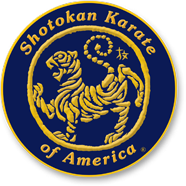Sparring (kumite) is a form used to apply offensive and defensive techniques practiced in the kata, under more realistic conditions, in which by prearrangement between participants one applies offensive and defensive techniques. Karate, to the very end, should be practiced with kata as the principal method and sparring as a supporting method.
Karate-ni sente nashi 空手に先手 無し [ からてに せんて なし ]
- Karate 空手 [ からて ] (literally ‘empty handed’)
- ni [ に ] means ‘toward’ ‘karate-ni’ could be read ‘in karate’ or ‘toward karate’.
- Sente 先手 [ せんて ] (literally ‘first hand’) means ‘the first move’
- Nashi 無し [ なし ] literally ‘without’) means ‘does not exist’
So ‘karate-ni sente nashi’ means ‘the first attack does not exist in karate’ – a fundamental strategy in karate-do is to force the opponent to commit to a first attack – at the moment he does, you destroy him. (this phrase can also be translated, ‘there is no first attack in karate’).
It has long been said that there is no advantage to the one who makes the first attack in karate, and whether performing kata or kumite, the front fist is used for defense and the fist held to the back is used for offense. Consequently, immediately following (without a hairbreadth delay) the blocking of a opponent’s attack with the front fist, the rear fist is used to destroy the opponent. If there is even the slightest delay in the movement, one will be forced into the predicament of maintaining a defensive role. There are times, depending upon the moment or adjusting to a changing situation when the defensive hand becomes an offensive hand (changing hands, or ‘hente’), and frequently in actual cases it is more effective than the orthodox use.
In SKA, we practice the following kumite forms:
| Ten no Kata Ura | prearranged single engagement matches |
| continuous attacks | |
| Sanbon gumite | triple engagement match |
| Ippon gumite | single engagement match |
| Jiyu-ippon gumite | free single engagement match |
| Jiyu kumite | free sparring |
| Torite | escaping |
| Suwari-waza | seated techniques |
| Nage jiyu kumite | long distance free sparring |
| Nage-no-waza | throwing techniques |
| Iai | closest distance single engagement match |
